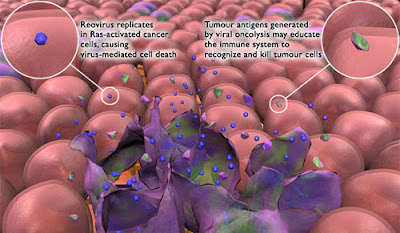Virus vs. Cancer: Reolysin Reovirus in Multiple Human Trials
 Viruses are hardy pre-lifeforms, that have played a major role in the evolution of humans and other animals and plants. The articles featured in this posting deal with the reovirus labeled Reolysin, by Canadian company Oncolytics.
Viruses are hardy pre-lifeforms, that have played a major role in the evolution of humans and other animals and plants. The articles featured in this posting deal with the reovirus labeled Reolysin, by Canadian company Oncolytics.The novel anti-cancer therapy, REOLYSIN®, is a living virus, not a chemotherapy drug, that is toxic to cancer cells but not harmful to normal cells. This novel therapy, using a living virus, is the first of its kind available at CTRC.From article discussing human trials of Reolysin for metastatic sarcomas to the lung.
...“This novel therapy has shown success because the reovirus replicates in and destroys the cancer cells within the patient’s body,” said Mita. “Cancer cells have several molecular and genetic abnormalities. In normal, healthy cells, the reovirus is unable to reproduce because of an enzyme named PKR. The enzyme is suppressed in cancer cells, and therefore the reovirus can replicate in the cancer cell and kill it.”
“REOLYSIN® typifies the true targeted therapy approach that seeks to use fundamental differences between cancer and normal cells as the basis for effective anti-cancer approaches and we are thus very excited about the this study,” said Francis Giles, MD, director of the CTRC Institute for Drug Development.
Another trial is ongoing in the UK:
The trial (REO 010) has two components. The first is an open-label, dose-escalating, non-randomized study of REOLYSIN(R) given intravenously with docetaxel every three weeks. A standard dosage of docetaxel will be delivered with escalating dosages of REOLYSIN(R) intravenously. A maximum of three cohorts will be enrolled in the REOLYSIN(R) dose escalation portion. The second component of the trial will immediately follow and will include the enrolment of a further 12 patients at the maximum dosage of REOLYSIN(R) in combination with a standard dosage of docetaxel.Source
Eligible patients include those who have been diagnosed with advanced or metastatic solid tumours such as bladder, prostate, lung or upper gastro-intestinal cancers that are refractory (have not responded) to standard therapy or for which no curative standard therapy exists. The primary objective of the trial is to determine the Maximum Tolerated Dose (MTD), Dose-Limiting Toxicity (DLT), recommended dose and dosing schedule and safety profile of REOLYSIN(R) when administered in combination with docetaxel. Secondary objectives include the evaluation of immune response to the drug combination, the body's response to the drug combination compared to chemotherapy alone and any evidence of anti-tumour activity. This is the third trial beginning in 2007 that is examining the role of REOLYSIN(R) in combination with standard chemotherapeutics.
An animal model study using childhood sarcoma cell lines demonstrated significant activity of Reolysin against childhood sarcomas.
Particular viruses can be very useful for treating human disease, and eventually for augmenting normal human function and lifespan. That is because viruses have evolved to be excellent gene therapy vectors, and clever cell sneaks. Viruses can slip into cells and into cell nuclei, and have their way with the cell and its transcriptional apparatus--before the cell is even aware that anything has changed.
Viral therapies have the potential to be misused or misdirected, just like any other revolutionary approach to medicine and life extension. But it is important to understand that the tools that viruses bring to the table are significant, and are the result of billions of years of viral/cellular co-evolution.
Labels: cancer, viral therapy


